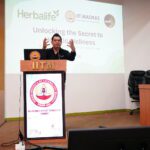Since osteoporosis or the extreme thinning of bones does not give any warning signals, the only way to arrest it in its tracks is a regular check on your bone mineral density
New Delhi, June 12, 2017 : At 29 years of age, Shobha (name changed) was too young to suffer from low bone density. However, after she slipped on the stairs and suffered a fracture in her hip, tests revealed she had osteoporosis of the level usually prevalent in women over 60.
Bone depletion or osteoporosis as we call it makes people extremely prone to fractures and is a common phenomenon experienced with ageing. This is why hip fractures and wrist injuries in the elderly are very frequent. But this bone depletion does not develop overnight; it is a progressive process that begins in younger years. Even though the process starts early, warning signs of progression and bones being eaten away are not noticed.
Surprising as it may be, Shobha is not an exception. Many Indian women in metro cities and city suburbs are suffering from poor bone health, low bone density, and early onset of osteoporosis. In fact, doctors nowadays are blaming lifestyle factors such as smoking and high alcohol consumption as major risk factors for osteoporosis.
According to International Osteoporosis Foundation, osteoporosis causes more than 8.9 million fractures annually across the globe. This translates into an osteoporotic fracture every 3 seconds. As we age, the rate of loss of minerals in the bones overtakes the rate of bone formation. By the time, we reach our sunset years, this bone depletion has become so enormous that the bones are almost fragile or porous, hence the term osteoporosis or ‘disease of the porous bones’.
The rate of bone depletion is not the same in every person. Moreover the earlier, you reach the osteoporosis stage will be inversely proportional to how thick your bones were at 35 years of age. The only way to keep a tab on this progression and address it before severe damage is done to the bones is through regular screening and testing. These screenings check the density and help in knowing exactly how thick or thin bones are.
Most women get tested for Osteoporosis only in their 40’s, by which time the depletion of bones has already begun. At the time of puberty or Menarche as some call it, a woman gains a 1/3rd of her bone mineral density. Estrogen plays a crucial role in bone formation and after puberty, influences the bone growth in girls. The onset of menarche is crucial in determining the bone health status of women in later years. Early and ideal menarche conditions are associated significantly with greater retention of bone density among adults. Late menarche is a major detrimental factor for poor bone mass.
Another milestone in a woman’s life is giving birth to a baby. During pregnancy, the baby growing in the mother’s womb needs plenty of calcium to develop its skeleton. This need is especially great during the last 3 months of pregnancy, when the baby is growing quickly and has the greatest need for calcium. If the mother doesn’t get enough calcium, her baby will draw what it needs from the mother’s bones. Breastfeeding also impacts the calcium reserves in a woman. Although pregnant women absorb calcium from food and supplements better than women who are not pregnant, their overall bone health is at risk. Any bone mass lost during pregnancy is typically restored within several months after the baby’s delivery (or several months after breastfeeding is stopped). Even then, it is advisable to get your bone health checked at this time.
At the time of menopause, the lack of estrogen in the body leads to the natural development of osteoporosis. It is estimated that the average woman loses up to 10% of her bone mass in the first five years after menopause. Early menopause (before age 45) and any long phases in which the woman has low hormone levels and irregular menstrual periods can also cause loss of bone mass. Women after the age of 50 have to be very cautious in regard to regular screenings to catch signs of osteoporosis and take precautionary measures.
To reduce your risk of osteoporosis, eat a diet rich in calcium and do regular weight-bearing exercise. These lifestyle habits are best started in childhood to get the most benefits. Taking calcium and vitamin D supplements regularly, adopting weight bearing exercises to strengthen your bones and other similar measures can actually help you prevent osteoporosis and have a safer older age.
Dr.Maninder Shah Singh Sr.Consultant – Foot & Ankle Indian Spinal Injuries Centre








whoah this blog is great i love reading your posts. Stay up the good work! You understand, a lot of persons are hunting round for this information, you could help them greatly.
http://www.borvestinkral.com/